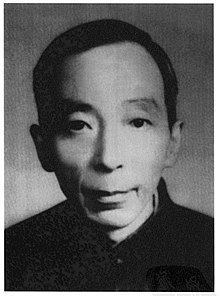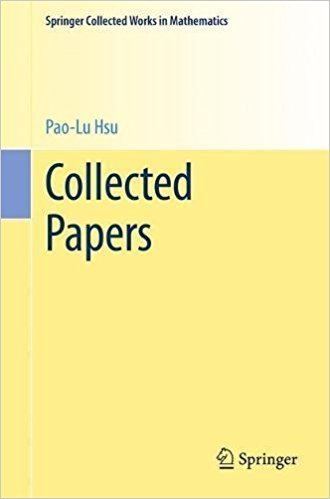Nationality China | Role Mathematician Name Pao-Lu Hsu Books Collected Papers | |
 | ||
Born September 16, 1910Beijing ( 1910-09-16 ) Institutions School of Mathematical SciencesPeking University Doctoral advisors Egon PearsonJerzy Neyman Died December 18, 1970, Beijing, China | ||
Pao-Lu Hsu (simplified Chinese: 许宝騄; traditional Chinese: 許寶騄; pinyin: Xǔ Bǎolù; September 1, 1910 – December 18, 1970) was a Chinese mathematician noted for his work in probability theory and statistics.
Contents

Hsu's work in statistics
In 1938, Hsu's first two statistical papers, which appeared in Vol. II of the Neyman–Pearson edited Statistical Research Memoirs, were concerned with Behrens–Fisher problem and the optimal estimate of σ2 in the Gauss–Markov model. The most important paper in this series is where Hsu obtains the first optimum property for the likelihood ratio test of the univariate linear hypothesis, in fact essentially the first nonlocal optimum property for any hypothesis specifying the value of more than one parameter. From 1938 to 1945, Hsu published several papers in the forefront of the development of the theory of multivariate analysis. He obtained several exact or asymptotic distributions of important statistics in the theory of multivariate analysis.
Hsu's work in probability
Hsu was an expert in manipulating characteristic functions. He used characteristic functions as a tool to obtain distribution of certain random variables, to determine the limiting distribution of series of random variables. For one example, the Hsu–Robbins–Erdős theorem.
For another example, around 1940, a challenging problem was to find a solution of the most general form of the Central Limit Theorem, which drew the attention of many famed mathematicians, such as Levy, Feller, A. N. Kolmogorov, and Gnedenko. Hsu was a competitor and the competition showed that he was also on the peak. Paper was Professor Hsu's manuscript which Hsu mailed to Professor K. L. Chung in 1947. In this paper Hsu independently obtained the necessary and sufficient condition under which the row sums of a triangular array of infinitesimal random variables, independent in each row, converges in distribution to a given infinitely divisible distribution. Despite the fact that Gnedenko obtained the same result in 1944, Hsu's method is direct and has its own trait.
Life and career
Pao-Lu Hsu was born in Beijing on September 1, 1910. But his forefathers were natives of Hangzhou, Zhejiang Province. He was from a prominent intellectual family. In his childhood, he received solid training in both traditional Chinese and modern western cultures. He graduated from Tsinghua University in 1933, majoring in mathematics. After his graduation, he worked at Peking University as a teacher. In the meantime, he published a joint paper with Tsai-han Kiang (Jiang Zehan) on the numbers of nondegenerate critical points, which showed his solid mathematical foundation and research capability. In 1936, he went to University College London and spend four years studying mathematical statistics. During this period, with his strong mathematical skill combining with advanced statistical ideas, he wrote a series remarkable papers. He earned his Ph.D. in 1938 and Sc.D. in 1940. From London, he returned to China, accepting a professorship in the Department of Mathematics, Peking University. Nevertheless, the ensuing years were a period of great difficulty and hardship for him. During the years 1943-44, he corresponded with Jerzy Neyman (who was by this time at Berkeley) about statistics-related matters, but also mentioning in these letters the great hardship he was suffering, particularly starvation.
In 1945, he went to the United States, visiting the University of California at Berkeley, Columbia University, and the University of North Carolina at Chapel Hill. In 1947, he returned to Beijing and thereafter he was engaged in teaching mathematics at Peking University for more than 20 years. Unfortunately, poor health had dogged Hsu from 1950 onward. Although many concerned about his health repeatedly suggested he go abroad to recuperate, he politely refused, insisting on teaching and continuing his research work.
In 1956, Dr. Hsu was made Director of the first research institute for probability and statistics to be established in China. But his health continued to worsen, forcing him to work at home, which included giving lectures at his home to graduate students and young teachers using a blackboard hanging on a wall of his room.
A month before his death in 1970 his manuscript on the relationship between experimental design and algebraic coding theory was completed, with such being his final legacy. Hsu died in his home on the campus of Peking University on December 18, 1970, from chronic tuberculosis. Found beside his bed the day after his death were piles of manuscripts that "serve as a testimony to the super-human fortitude with which he exerted himself for a period of more than 20 years..." In total, he had published more than 40 papers.
There was a memorial meeting and Pao-Lu Hsu Award in his honor. Hsu is a Fellow of the Institute of Mathematical Statistics (IMS) and Academician of the Academy of Science of China. Memorial meetings were held in 1980, 1990, 2000 & 2010 at Peking University.
Professor Hsu's main research areas were mathematical statistics and probability theory. He was an expert in operating matrix, manipulating characteristic functions and integral transformation. Hsu was a world-class statistician and is considered to be the founder of probability and statistics in China.
He influenced many students such as Theodore Wilbur Anderson, Erich Leo Lehmann, and Chung Kai-lai.
